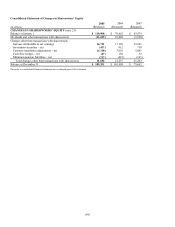GE 2005 Annual Report Download - page 60
Download and view the complete annual report
Please find page 60 of the 2005 GE annual report below. You can navigate through the pages in the report by either clicking on the pages listed below, or by using the keyword search tool below to find specific information within the annual report.(60)
Commercial aircraft are a significant concentration of assets in Infrastructure, and are particularly subject to
market fluctuations. Therefore, we test recoverability of each aircraft in our operating lease portfolio at least
annually. Additionally, we perform quarterly evaluations in circumstances such as when aircraft are re-leased,
current lease terms have changed or a specific lessee’ s credit standing changes. Future rentals and residual values
are based on historical experience and information received routinely from independent appraisers. Estimated cash
flows from future leases are reduced for expected downtime between leases and for estimated technical costs
required to prepare aircraft to be redeployed. Fair value used to measure impairment is based on current market
values from independent appraisers.
We recognized impairment losses on our operating lease portfolio of commercial aircraft of $0.3 billion
and $0.1 billion in 2005 and 2004, respectively. In addition to these impairment charges relating to operating leases,
we recorded provisions for losses on financing receivables related to commercial aircraft of $0.2 billion in 2005,
primarily related to Northwest Airlines Corporation (Northwest Airlines), and $0.3 billion in 2004, primarily related
to US Airways and ATA Holdings Corp.
Certain of our commercial aviation customers are operating under bankruptcy protection while they
implement steps to return to profitable operations with a lower cost structure. At December 31, 2005, our largest
exposures to carriers operating in bankruptcy were to Delta Air Lines, $2.4 billion; UAL Corp., $1.4 billion; and
Northwest Airlines, $1.3 billion. Our financial exposures to these carriers are substantially secured by various
Boeing, Airbus and Bombardier aircraft and operating equipment. On February 1, 2006, UAL Corp. emerged from
bankruptcy protection.
Further information on impairment losses and our exposure to the commercial aviation industry is provided
in the Operations-Overview section and in notes 10, 15 and 29.
GOODWILL AND OTHER IDENTIFIED INTANGIBLE ASSETS. We test goodwill for impairment annually
and whenever events or circumstances make it more likely than not that an impairment may have occurred, such as a
significant adverse change in the business climate or a decision to sell or dispose of a reporting unit. Determining
whether an impairment has occurred requires valuation of the respective reporting unit, which we estimate using a
discounted cash flow method. When available and as appropriate, we use comparative market multiples to
corroborate discounted cash flow results. In applying this methodology, we rely on a number of factors, including
actual operating results, future business plans, economic projections and market data.
If this analysis indicates goodwill is impaired, measuring the impairment requires a fair value estimate of
each identified tangible and intangible asset. In this case we supplement the cash flow approach discussed above
with independent appraisals, as appropriate.
We test other identified intangible assets with defined useful lives and subject to amortization by
comparing the carrying amount to the sum of undiscounted cash flows expected to be generated by the asset. We test
intangible assets with indefinite lives annually for impairment using a fair value method such as discounted cash
flows.
Further information is provided in the Financial Resources and Liquidity-Intangible Assets section and in
notes 1 and 16.
























